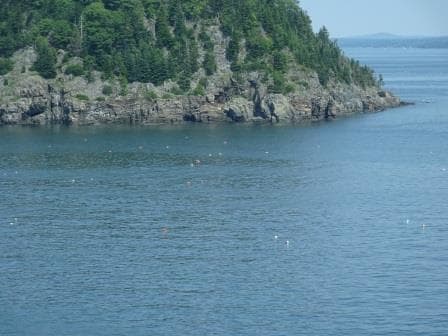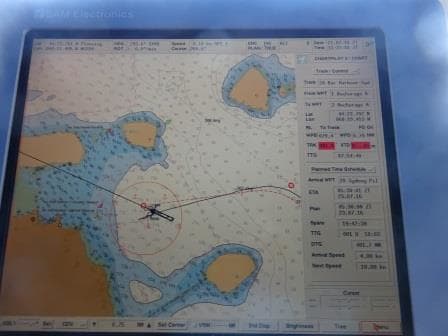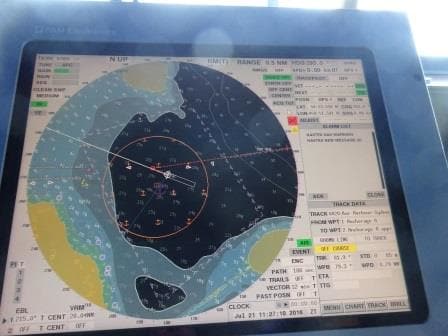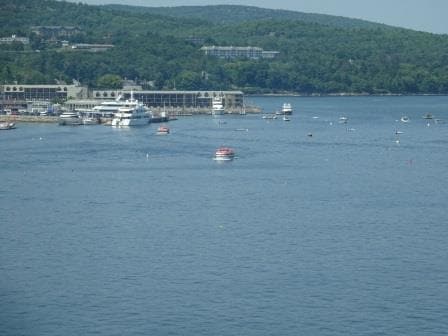At 09.30 am we dropped anchor in the South Bay of Bar Harbor and at 10.00 we commenced our tender service after the ship had been cleared. As we were coming from Boston, USA, clearance was easy and not need for long lines at emigration. Rumors have it that they want to build a cruise ship dock here in Bar Harbor but thus far nothing has happened and thus we anchor and run a tender service.
There are two anchorages, North and South. The North one is further out but wider and the South one is nearer to the port but hampered in swinging size due to the large numbers of lobster pots in the area. Today we were the only ship and as the Rotterdam is not that long, it could anchor at the South anchorage. Among the captains there is always a sort of discussion going on about which anchorage is the best.

Hundreds or lobsterpot buoys all attached to lobsterpots on the bottom. Those ropes are not nice to get in the propellors.
It depends mainly on the wind. The holding ground (which grips the anchor and the anchor chain) is not so good at the South anchorage. The composition/mixture of the mud and shells tends to cause the anchor to start sliding if the wind brings more force onto the ship and thus onto the anchor and then you can get set towards the shore (and all those lobsterpots) very fast. The ever present current helps the ship to drift even more quickly.
The North anchorage has the better holding ground and there is much more room. But it is a longer tender distance and a small island obscures the bridge from seeing the dock and the tender route. Thus the ship cannot follow each tender when it sails to and fro. Although the tender drivers are very capable and have Radar and AIS on board, there are a lot of pleasure craft messing around during the day and that results sometimes in very original applications of the Rules of the Road. So everybody has to be very vigilant.
Even more so when we get restricted visibility and a dense white cloud descends over Bar Harbor. Cruise ships normally do not stop tendering but we add an officer to each tender who acts as a sort of Captain and monitors the route and the traffic, while the Quartermaster (Coxswain for the British) concentrates on the driving. Also we add then an extra officer to the bridge complement (Most of the time the Captain or the Staff Captain) so one officer can fully concentrate on following the route of the tenders by monitoring the AIS signal (AIS = Automatic Identification System transponds/ gives a signal which can be seen on the ships radar. It is only compulsory for ships larger than 300 tons but all the HAL tenders have them as well)
Bar Harbor can be quite a complicated harbor when there is no visibility, especially as right in front of the entrance there is an obstruction, which for some unknown reason always manages to get into the way when you cannot see anything. Many a sailor only realized that this obstruction is really there after bumping into when sailing into the small white world. It is marked by a big yellow/black buoy which gets hit quite regularly as well.
Today we are having gorgeous weather. Outside the sea was just warm enough to not let the air condensate and thus the Captain did not have to honk the horn. Tomorrow we are at sea and coming into colder water, while nearing Sydney Nova Scotia, and things might change again.
I am now on board the Ms Rotterdam in full swing with carrying out a full ship inspection for the Captain as we will have a major Carnival Head Office audit coming up in August. Thus I am going through all the lockers, public spaces, work area’s etc. etc. to see if we conform with all the Company and Corporate regulations. (And Corporate has created a lot more than just what the law requires us to do!!!!) Sometimes it looks as if you can not see the trees for the Forest anymore and vice versa. As I grew up with the forest so to speak I look at trees and can see if they need a little TLC.
Today I was quite intrigued by the escape alarms in Club HAL.
As with every public space, our children center Club HAL, has emergency exits. These are normally closed by a tumbler lock which you can open by just turning a little wheel. Toddlers, tweens and teens can do that as well. The Ladies from Club HAL cannot see all these exists when they are supervising the chaos of what a children’s club is and thus we have put alarms on the doors. That is not required by law but is a company policy. It is not a good idea if suddenly one or more of them decide to disappear without giving notice. Parents tend to panic if Little Johnny is not where they left him.
So I spend some time letting the alarms go off all over the Club HAL much to the excitement of the kids present. Even in port today we had a few on board as for some of them Bar Harbor did not offer any competition in relation to the ships Pizza and Ice Cream.
Thus tomorrow we are at sea; sailing around Cape Breton and then it is time for Sydney Nova Scotia, where they have the largest violin in the world standing on the dock side.




August 2, 2016 at 3:38 pm
I was wondering, Captain. Are only Quartermasters steering the tenders? All three teams of two ¼ Masters?